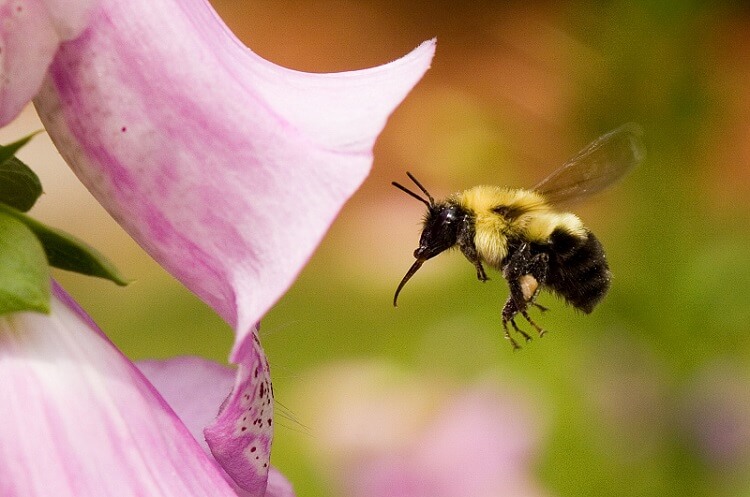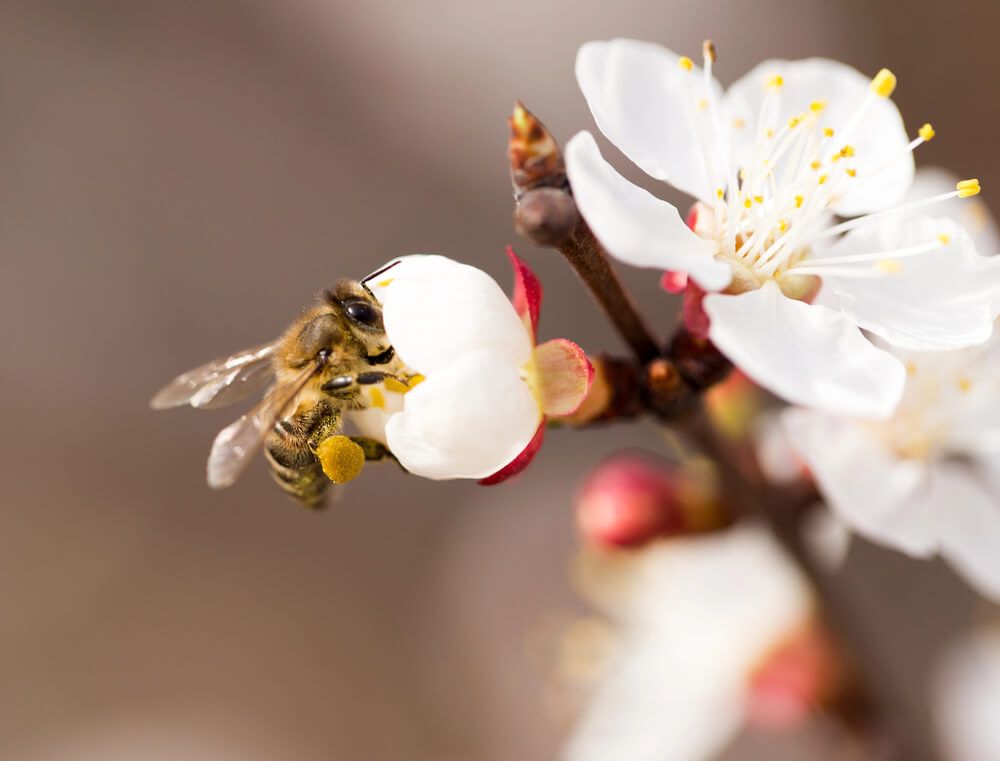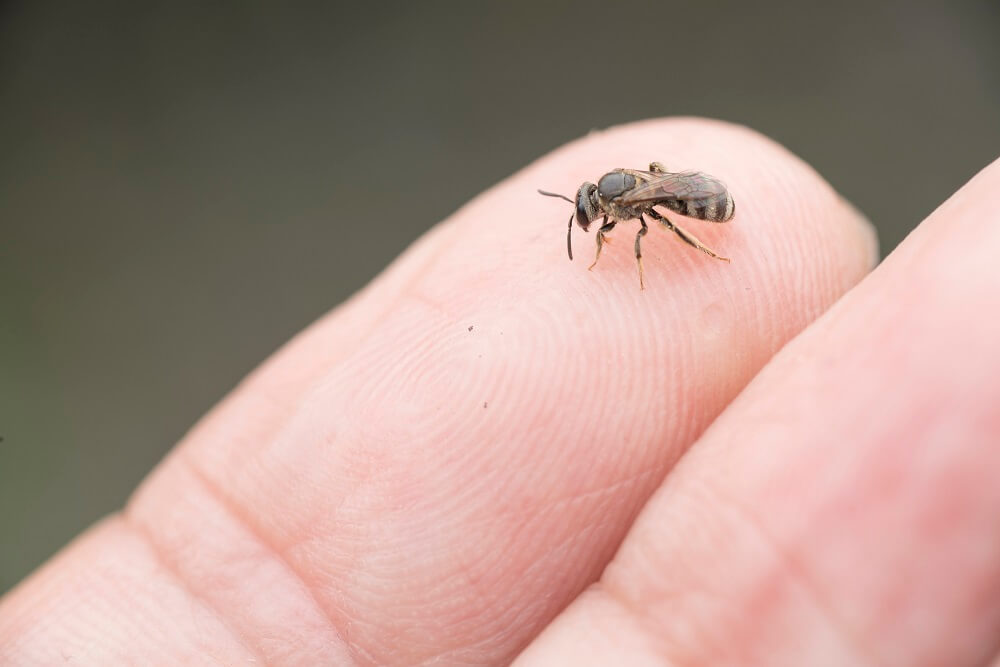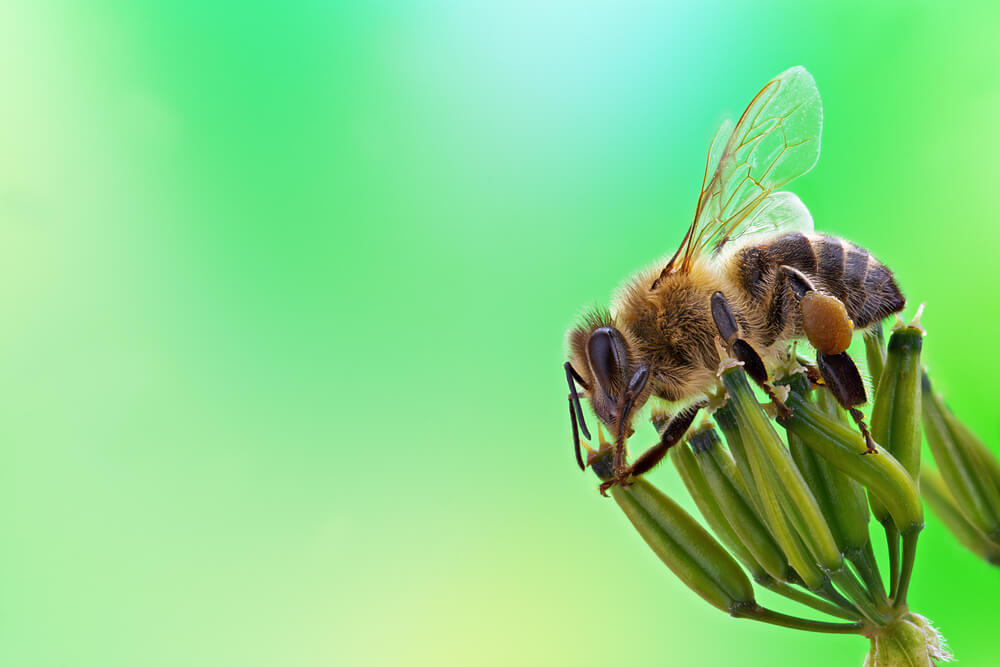Table of Contents:
What Does a Bee Do With Its Tongue?
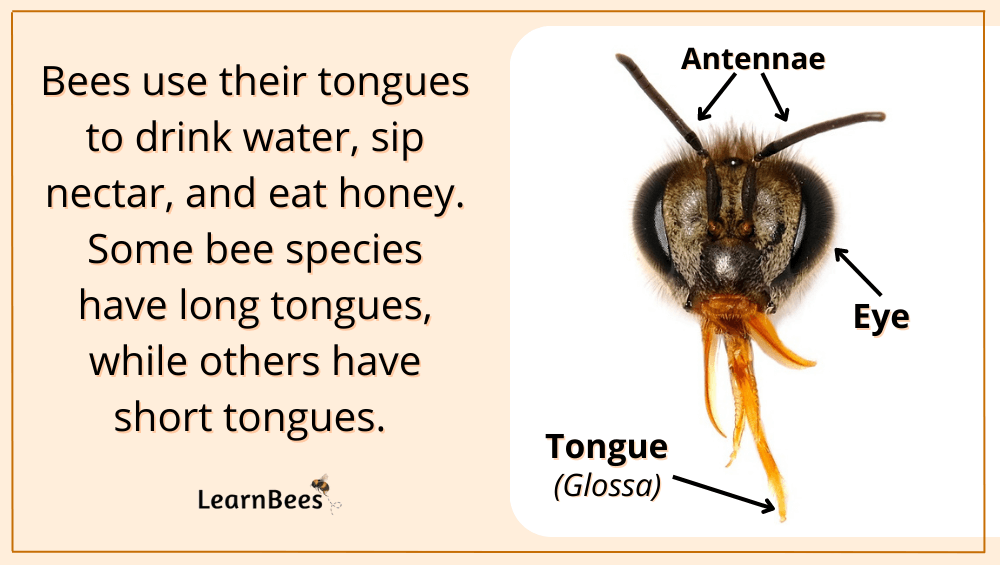
Bees use their tongues to drink water and eat things like nectar and honey.
Nectar is found inside flowers, and bees use their long tongues to reach it. A bee’s tongue functions like a straw, allowing the bee to “slurp” the nectar out of the flower.
But here’s the thing:
Bees’ mouthparts are complex.
If you look at pictures of a bee’s mouth, you’ll notice that it has multiple moving parts. From there, the main parts can be divided into subparts.
For example, a bee’s tongue is coated with tiny hairs that help them mop up nectar. These tiny hairs have pores that allow molecules to pass through and stick to receptor sites on the taste sensors.
This is how a bee tastes and smells nectar from flowers.
Additionally, bees use their tongues for drinking water.
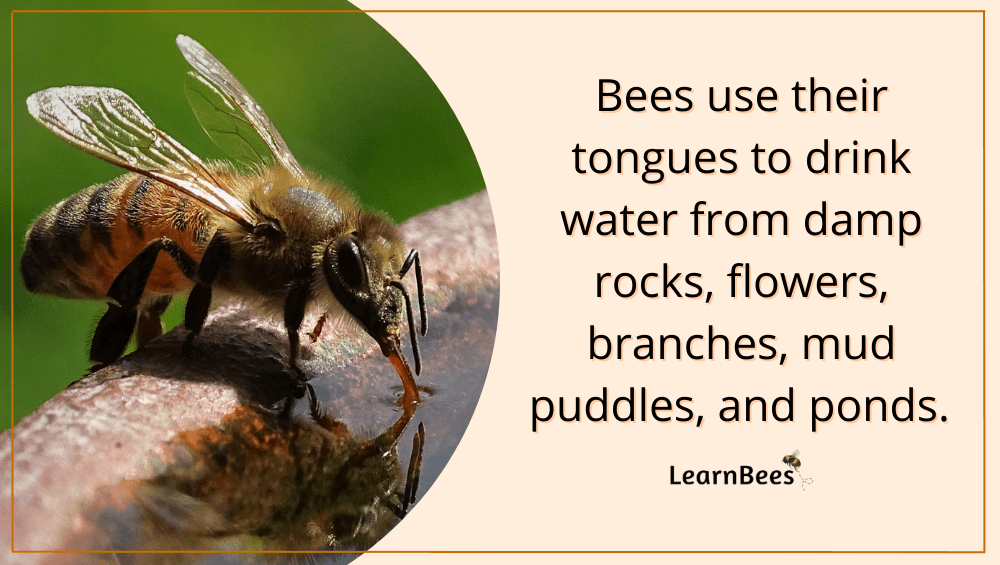
Bees use their tongues to collect water from ponds, rivers, damp rocks, morning dew, branches, and mud puddles.
With that in mind, bees must be careful about large bodies of open water since they can’t swim. They rely on safe landing perches like rocks, sticks, or pond edges to safely drink from.
Bees risk drowning if they don’t have a safe, dry place to stand on and drink.
Now you might be wondering…
Why do bees stick their tongue out?
Scientists have discovered that bees have something called proboscis extension reflex (PER). Meaning, bees automatically stick their tongues out when they sense food.
The scientists said:
“The Proboscis Extension Response (PER) in honey bees is a natural behavioral reflex in which the honey bee extends its proboscis [tongue] in response to antennal stimulation with a sugar solution. During normal foraging behavior, PER occurs when the honey bee finds nectar in a flower.”(1)
What is a Bee’s Tongue Called?

The true scientific term for a bee’s tongue is glossa.
That said, many writings call a bee’s tongue the proboscis. However, the proboscis actually includes many parts of the bee’s mouth – not just the tongue.
Think about it this way:
A human’s mouth comprises of a tongue, lips, gums, and teeth. When referring to something inside the mouth, we use specific words like “teeth” or “gums.”
The same goes for bees.
When referring to a bee’s tongue, we should use the specific term “glossa.”
Proboscis refers to the bee’s mouth as a whole and can be too broad. Remember that the proboscis has multiple parts, including the maxillae, labial palpi, and glossa.
Nevertheless, you’ll still see where people continue to use “proboscis” as the name for a bee’s tongue. But now you know the difference.
How Big is a Bee’s Tongue?
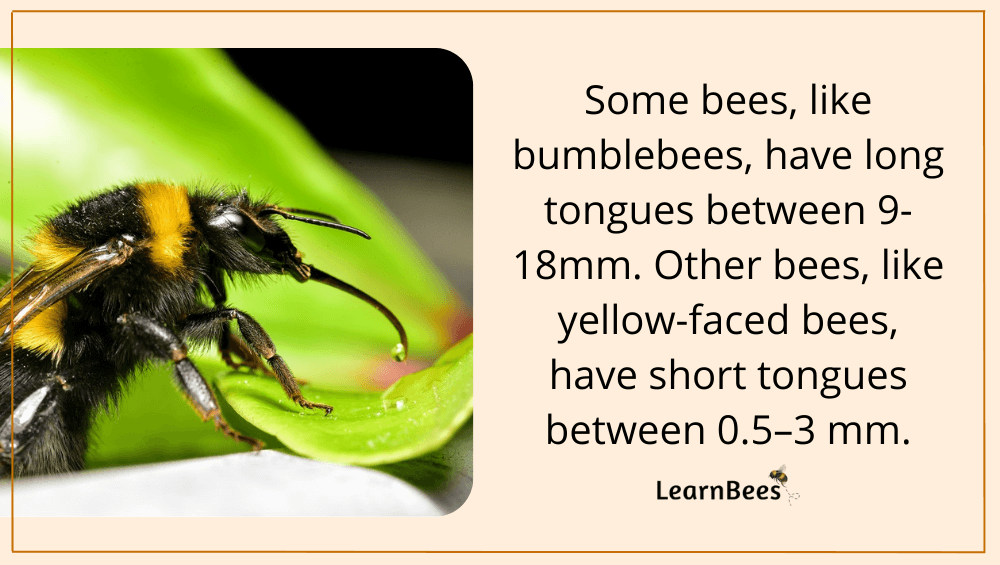
Tongue length depends on the bee species.
A bee’s tongue is measured in millimeters, with each species having different sizes. For instance, bumblebees can have tongues ranging from 9–18 mm.(2)
In contrast:
Yellow-faced bees (Hylaeus) have tongues that are only between 0.5–3 mm.(2)
As a result, bees are typically divided into three categories: long tongues, medium tongues, and short tongues.
Long-tongued bees, like some bumblebee species, use their tongues to reach inside flowers with deep tubes. As a result, they can collect the nectar that short-tongued bees can’t reach. This is why bumblebees have no trouble with plants with deep flowers, such as hostas or foxgloves.
On the other hand:
Short-tongued bees, such as sweat bees, focus on flowers that are easier to collect nectar from. Examples include sunflowers and zinnias.
But interestingly enough?
Bees don’t always let their short tongues stop them.
In fact, short-tongued bees use their jaws to make minor cuts at the base of flowers. These small incisions allow the bee to collect nectar from blossoms with long corollas.
FAQs on a Bees Tongue
- What does a bee do with its tongue?
- Is a bee’s tongue called a glossa?
- Why do bees stick their tongue out near flowers?
- Why do bees have long tongues?
- Why do bees have short tongues?
- How many tongues do bees have?
- Do carpenter bees have tongues?
- Do bumblebees have tongues?
- Do honeybees have tongues?
- Why do bumblebees stick their tongues out?
- What is a bumblebee tongue called?
What does a bee do with its tongue?
The primary function of a bee’s tongue is to collect nectar from flowers.
Bees have tongues coated with tiny hairs that act as taste sensors. These taste sensors aren’t limited to a bee’s tongue, though. They’re also found on the bee’s antennae and front feet.
Once bees use their tongues to lap up nectar from flowers, they store it inside an internal organ called a honey crop. The bee returns the nectar to the nest once the honey crop is full.
Some species of bees, like honeybees, will turn nectar into honey. Honeybees use their tongues to eat both nectar and honey. But not all bees make honey like honeybees do.
Bees also use their tongues for drinking water. Water is important for bees because it hydrates them and helps them regulate their nest temperature. For example, if a nest gets too hot, the bees will use their tongues to collect water and then spray it over their bodies to cool down. They use their wings to “fan” the water, which creates an air conditioning effect.
—> Go back to the FAQs on bees tongues
More to Explore:
- Ground Bees: Are They a Threat to Your Yard?
- Wasps vs. Honeybees: Are They Different?
- Do Bumble Bees Bite?
Is a bee’s tongue called a glossa?
Yes, a bee’s tongue is specifically called a glossa.
The glossa is covered in small hairs that allow the bee to “mop” up nectar. Nectar is a sugary, sweet liquid that sticks to the bee’s hairy tongue. The glossa is then withdrawn, and the bee swallows the nectar.
However, many people refer to a bee’s tongue as the proboscis. This isn’t entirely accurate.
A bee’s proboscis (mouth) comprises of many parts, not just the tongue. In addition to the glossa (tongue), a bee’s proboscis also includes the maxillae and labial palpi. These are mouthparts that help the bee eat and drink.
Think of it this way:
A human’s mouth comprises of a tongue, lips, gums, and teeth. When referring to something inside the mouth, we use specific terms such as “teeth” or “gums.”
The same is true for bees. When referring to a bee’s tongue, we should use the specific term “glossa.” Proboscis refers to the bee’s mouth as a whole and can be too broad in some cases.
Nevertheless, you’ll still see where people continue to use “proboscis” to define a bee’s tongue. But now you know the difference.
—> Go back to the FAQs on bees tongues
More to Explore:
Why do bees stick their tongue out near flowers?
Flowers provide bees with food, so it’s their instinct to stick their tongue out around them, much like a dog or cat salivates when they expect to be fed.
So don’t be alarmed if you see a bee with its tongue hanging out while it’s buzzing around flowers. The bee is simply anticipating the collection of nectar. Nectar gives the bees carbohydrates that give them the energy to fly, nest, and defend themselves.
—> Go back to the FAQs on bees tongues
More to Explore:
- Do Carpenter Bees Pollinate?
- How Long Do Bumble Bees Live?
- Honeybees vs. Bumblebees: How Do They Compare?
Why do bees have long tongues?
Some bees have long tongues because they must reach deep inside flowers to collect nectar.
But remember:
Different bee species have different tongue lengths. There are thousands of other bee species worldwide. Each can have varying tongue lengths, depending on how they’ve evolved to collect food from local flowers.
For example, honeybees have shorter tongues than bumblebees.
Honeybees primarily collect nectar from small flowers with short corollas (the petals surrounding the flower’s reproductive organs). Bumblebees, on the other hand, can drink from larger flowers with long corollas.
There are some flowers that both long-tongued bees and short-tongued bees frequent. Salvia, for example, is a favorite amongst many types of bees. Honeybees, carpenter bees, and bumblebees all flock to these flowers like there’s no tomorrow.
If you’re planting a bee-friendly garden, we suggest using various plants that appeal to many different bee species. Salvia, veronica, zinnias, celosias, hostas, and sunflowers are good choices.
You may notice that the bumblebees favor the flowers with the long corollas, while the honeybees favor the flowers with the shorter ones.
—> Go back to the FAQs on bees tongues
More to Explore:
- Do Queen Bees Eat Honey?
- Are Worker Bees Male or Female?
- Queen Bee Versus Worker Bees – How Do They Compare?
Why do bees have short tongues?
As mentioned, some bees have short tongues because they’ve adapted to the flowers in their area.
Depending on the flowers in their area, different bee species evolve to have different tongue lengths.
For example, honeybees have shorter tongues than bumblebees. Honeybees mainly drink nectar from small flowers with short corollas (the petals surrounding the flower’s reproductive organs). Bumblebees can drink from larger flowers with long corollas.
However, this doesn’t mean that short-tongued bees are always limited.
For example, short-tongued bees have been known to engage in “nectar robbing” when they can’t reach a flower’s nectar.
Nectar robbing occurs when a bee uses its mouth to make a small cut at the base of the flower petal. This allows the bee to access nectar that it couldn’t previously reach.
The only downside to this method is that the flower doesn’t get pollinated by the bee. But other long-tongued bees will likely come around and do the pollinating job instead.
—> Go back to the FAQs on bees tongues
More to Explore:
How many tongues do bees have?
All bees have one tongue, also known as a glossa. The tongue is an elongated, tube-like organ attached to the bee’s mouth.
The tongue is used for drinking nectar from flowers. When the bee sticks its tongue out, the nectar is drawn up using tiny hairs. Bee’s tongues have the same structure but can vary in length depending on the bee species.
For example, sweat bees have shorter tongues than honeybees. In turn, honeybees have shorter tongues than bumblebees.
—> Go back to the FAQs on bees tongues
More to Explore:
Do carpenter bees have tongues?
Yes, carpenter bees have tongues. Carpenter bees fall into the medium-tongued or long-tongued category, depending on the type of carpenter bee.
If a flower is too long for a carpenter bee to reach into, it will either find a new flower or make an incision into the base of the flower to gather the nectar. Such incisions are known as “nectar robbing.”
—> Go back to the FAQs on bees tongues
More to Explore:
Do bumblebees have tongues?
Yes, bumblebees have tongues. Most bumblebee species fall into the medium-tongue or long-tongue category of bees. The length of their tongue ranges from 9–18 mm.
—> Go back to the FAQs on bees tongues
More to Explore:
Do honeybees have tongues?
Yes, honeybees have tongues. Most honeybee species either have medium or long tongues. They use their tongues to collect nectar, drink water, and of course, eat honey during the winter when nectar sources are low.
—> Go back to the FAQs on bees tongues
More to Explore:
Why do bumblebees stick their tongues out?
Bumblebees will stick their tongues out when gathering nectar from a flower. Scientists also discovered that bees would stick their tongues out when they’re near flowers to show that they’re anticipating food.
Bumblebees are a type of bee that generally has a long tongue. This allows bumblebees to gather nectar from flowers that other, shorter-tongued bees cannot.
The long tongue also allows bumblebees to drink water easily. When a bee drinks water, it wicks the liquid up with its tongue.
—> Go back to the FAQs on bees tongues
More to Explore:
What is a bumblebee tongue called?
A bumblebee tongue is called a glossa. The glossa is an elongated, tube-like organ attached to the bee’s mouth. It’s used for drinking nectar from flowers.
Like honeybees, bumblebees are also a type of bee that produces honey. So, they also use their tongues to eat honey.
But that said, bumblebees don’t produce nearly as much honey as honeybees. Bumblebee colonies are much smaller than honeybee colonies. They also don’t overwinter together like honeybees do.
